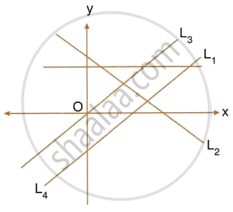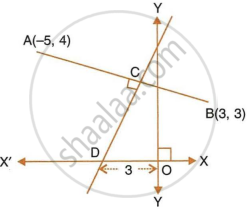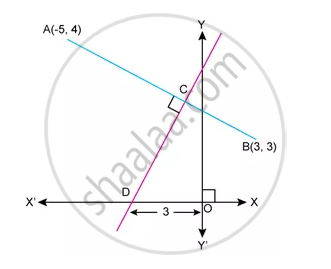Advertisements
Advertisements
Question
Match the equations A, B, C and D with the lines L1, L2, L3 and L4, whose graphs are roughly drawn in the given diagram.
A ≡ y = 2x;
B ≡ y – 2x + 2 = 0;
C ≡ 3x + 2y = 6;
D ≡ y = 2

Solution
Putting x = 0 and y = 0 in the equation y = 2x, we have:
LHS = 0 and RHS = 0
Thus, the line y = 2x passes through the origin.
Hence, A = L3
Putting x = 0 in y − 2x + 2 = 0, we get, y = −2
Putting y = 0 in y − 2x + 2 = 0, we get, x = 1
So, x-intercept = 1 and y-intercept = −2
So, x-intercept is positive and y-intercept is negative.
Hence, B = L4
Putting x = 0 in 3x + 2y = 6, we get, y = 3
Putting y = 0 in 3x + 2y = 6, we get, x = 2
So, both x-intercept and y-intercept are positive.
Hence, C = L2
The slope of the line y = 2 is 0.
So, the line y = 2 is parallel to x-axis.
Hence, D = L1
APPEARS IN
RELATED QUESTIONS
Is the line 3x + 2y = 5 parallel to the line x + 2y = 1?
Find the equation of the perpendicular bisector of the line segment obtained on joining the points (6, −3) and (0, 3).
The point P is the foot of perpendicular from A(−5, 7) to the line whose equation is 2x – 3y + 18 = 0. Determine :
- the equation of the line AP.
- the co-ordinates of P.
Find the equation of the line which is perpendicular to the line `x/a - y/b = 1` at the point where this line meets y-axis.
A (5, 4), B (–3,–2) and C (1,–8) are the vertices of a triangle ABC. Find the equation of median AD and line parallel to AB passing through point C.
Find:

- equation of AB
- equation of CD
Find Equation of CD

A straight line passes through the points P(–1, 4) and Q(5, –2). It intersects x-axis at point A and y-axis at point B. M is the mid-point of the line segment AB. Find:
- the equation of the line.
- the co-ordinates of point A and B.
- the co-ordinates of point M.
Three vertices of a parallelogram ABCD taken in order are A(3, 6), B(5, 10) and C(3, 2), find:
- the co-ordinates of the fourth vertex D.
- length of diagonal BD.
- equation of side AB of the parallelogram ABCD.
A line is parallel to Y-axis and is at a distance of 5 units from the Y-axis. Write the equation of that line.
